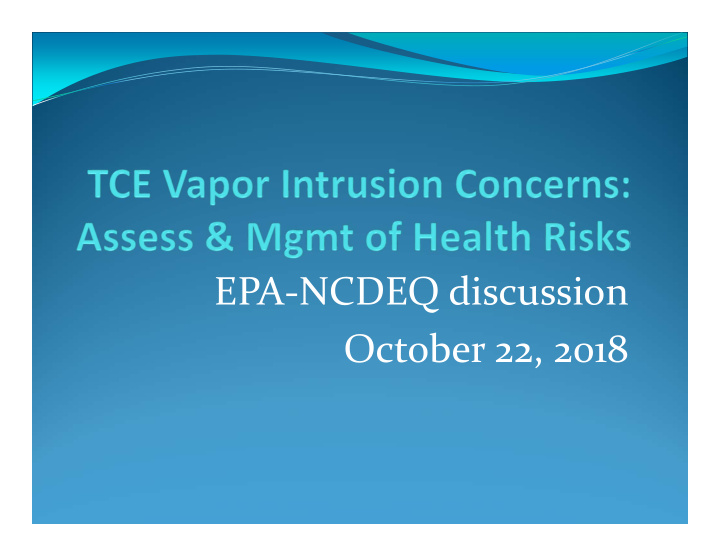



EPA ‐ NCDEQ discussion October 22, 2018
TCE Toxicity Changes Date(s): Cancer risk Chronic Removal Rationale (1E ‐ 6) from noncancer Management Level EPA RSL (HI=1) from Tables EPA RSL Tables 120 µg/m 3 based on Up to 1.2 µg/m 3 N/A CalEPA IUR of 2.0E ‐ 06 (µg/m 3 ) ‐ 1 6/2011 1E ‐ 4 risk 120 µg/m 3 based on 6/2011 to 1.2 µg/m 3 10 µg/m 3 CalEPA IUR of 2.0E ‐ 06 (µg/m 3 ) ‐ 1 NY RfC 1.0E ‐ 02 mg/m 3 9/2011 1E ‐ 4 risk 6.3 µg/m 3 based on 9/2011 to 0.43 µg/m 3 2.1 µg/m 3 IRIS IUR of 4.1E ‐ 06 (µg/m 3 ) ‐ 1 IRIS RfC 2.0E ‐ 03 mg/m 3 2013 HQ of 3 6.3 µg/m 3 based on 2014 0.48 µg/m 3 2.1 µg/m 3 IRIS IUR of 4.1E ‐ 06 (µg/m 3 ) ‐ 1 IRIS RfC 2.0E ‐ 03 mg/m 3 HQ of 3
Vapor Intrusion Guidance EPA released the final VI Technical Guides in 2015 Recommends use of multiple lines of evidence in evaluating and making decisions Discusses potential impact of indoor sources Describes how petroleum hydrocarbon vapors should be addressed Provides guidance about mitigation systems • Operations and maintenance • Monitoring and termination criteria • When is preemptive mitigation appropriate ? Address institutional controls, deed restrictions, and Superfund five ‐ year reviews
E.g., Site Specific Screening Table
EPA HQ TCE “guidance”
EPA HQ TCE “guidance” cont’d Summary Existing guidance provides that responders should consider early or interim action(s) where appropriate to eliminate, reduce, or control the hazards posed by a site. In doing so, IRIS generally provides the best available toxicological information in support of early or interim action for buildings where investigations of indoor air contamination identify site ‐ related concentrations of TCE.
TCE Removal Management Level (RML) for Indoor Air EPA Region 4 recommends using a chemical/site specific removal management level (RML) of 2 µg/m 3 based on a Hazard Quotient of 1 for residential exposures. This RML is protective of the most sensitive and vulnerable human receptor population, women in their first trimester of pregnancy, because of the potential for cardiac malformations in the developing fetus during this short timeframe.
Region 4 Recommenda�ons for ↑TCE Temporary relocation of residents and mitigation measures are recommended for the residential properties with confirmed TCE indoor air levels exceeding 2 µ g/m 3 . Mitigation effectiveness is defined as a reduction of the TCE indoor air concentration to below 2 µ g/m 3 . Resampling is needed for residences with mitigation systems to confirm that the TCE levels in the indoor air have decreased. For longer term action, the source of the VOC contamination should be addressed so that vapor intrusion is not a significant pathway for other current or future residences or businesses in the area.
Addition of the Subsurface Intrusion to the HRS
Addition of Subsurface Intrusion to the HRS Vapor Intrusion Contaminated Ground Water Intrusion Basement Contaminated ground water from overflowing sump Sump Contaminated Ground Water Plume 11
Scope of this Action • The rule affects only how EPA prioritizes sites for the NPL. • No direct regulatory impact. • Current NPL sites are not affected (VI screening is currently part of 5 ‐ year reviews). • No systematic re ‐ evaluation of legacy sites. Minimal impacts to other federal agencies which already identify and address vapor intrusion as part of their environmental programs. 12
Interim Mitigation Options
Sub‐Slab Venting
Temporary Indoor Filter
Questions or Comments?
Thank you for your time. Kevin Koporec, Toxicologist Technical Support, Superfund Division EPA Region 4 ‐ Atlanta koporec.kevin@epa.gov (404)562 ‐ 8644
Recommend
More recommend